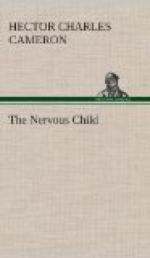If this diagnosis is made, then a full and clear explanation should be given to the mother, or at any rate to such mothers—and fortunately they are in the majority—who are capable of appreciating the point of psychology involved, and of correcting the management of the child so as to overcome the negativism. To attempt treatment by prescribing drugs, or in any other way than by correcting the faulty management, is to court failure. As Charcot has said, in functional disorders it is not so much the prescription which matters as the prescriber.
But the task of the doctor is often one of even greater difficulty. Often enough there will be a combination of organic disturbance with functional trouble. For example, a girl of eighteen years old suffered from a pain in the left arm which has persisted on and off since the olecranon had been fractured when she was two years of age. She was the youngest of a large family, and had never been separated for a day from the care and apprehensions of her mother. The joint was stiff, and there was considerable deformity. The pain always increased when she was tired or unhappy. Again, a girl had some slight cystitis with frequent micturition, and this passed by slow degrees into a purely functional irritability of the bladder, which called for micturition at frequent intervals both by day and night. In such cases treatment must endeavour to control both factors—the local organic disturbance must if possible be removed, and the faults of management corrected.
It is a good physician who can appreciate and estimate accurately the temperament of his patient, and the need for this insight is nowhere greater than in dealing with the disorders of childhood. It can be acquired only by long practice and familiarity with children. In the hospital wards we shall learn much that is essential, but we shall not learn this. The child, who is so sensitive to his environment, shows but little that is characteristic when admitted to an institution. Only in the nursery can we learn to estimate the influences which proceed from parents and nurses of different characters and temperaments, and the reaction which is produced by them in the child.




